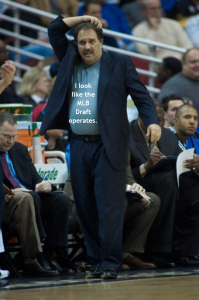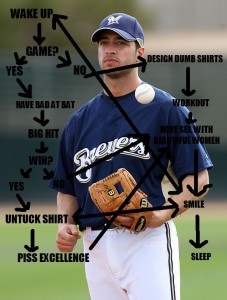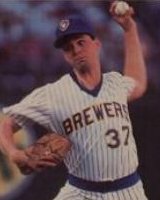By: Melissa S. Wollering
You can either love it for transforming losing teams like the Milwaukee Brewers into power-hitting playoff contenders or you can hate it for its reoccurring signing flaws and tortuous free-agent compensation system. Either way, we’ve spent some time picking apart the MLB Draft process and decided it needs a makeover as much as Stan Van Gundy’s frazzled hair, collarless shirts and pear-shaped sportcoats.
Doug Melvin and the Milwaukee Brewers make a perfect case study when exploring the challenges the MLB Draft creates for many teams. No other team has poured its concrete foundation using the draft quite like the Crew; with six of the team’s eight everyday pitchers and two of its current starters being products of it. You can also think Ryan Braun, Prince Fielder and Rickie Weeks.
Problems begin with the time and effort spent on signability rather than athletic ability. Take the NBA or NFL drafts. Organizations within don’t worry about the likelihood a player will sign. Each prospect has limited options. As the Milwaukee Brewers began pre-draft strategy discussions last week, GM Doug Melvin expressed frustration over the focus on how much effort and money it would take to sign individuals.
“We went through three or four players today in our meetings and when [the scouts] got done, they said he won’t sign unless he’s a first-round pick,” said Melvin.
Problems multiply exponentially as we study team compensation for the loss of free agents. A small-ball club may lose its highest quality player to the deep-pocketed New York Yankees and receive nothing more than a second-round selection in tandem with a supplemental pick between the first two rounds.
After the Yankees signed Mark Teixeira, CC Sabathia netted the Brewers the 39th selection instead of the 25th pick overall. Thank you statistical rankings! Ben Sheets never lived up to his free-agent potential courtesy his arm injury. He earned the Crew nothing. To make bad worse, Brian Shouse provided the Brewers with a compensation pick that mocked the CC situation—they’ll nab a prospect only eight picks beneath CC for Shouse. Yep. Shouse, Shouse, let it all out.
As a result of the NLDS birth, the Brewers will not draft until the 26th pick in the first round this year. That makes it nearly impossible to predict who Milwaukee will take, especially as the organization factors in the desire many prospects have to be selected in the first round “or else”.
San Diego State poster boy Stephen Strasburg will go first, complete with ‘best pitching prospect ever’ hype. After the No. 1 selection, it’s anyone’s guess. The bad news for the Brewers: since 1977, when the 26th pick first came in the first round, only three players selected in that spot became significant contributors in the big leagues. The good news: Dan Plesac was Milwaukee’s 26th selection in the 1983 draft.
Here’s to the Dan Plesac’s of the world. The rest of you? Don’t consider the second round “beneath you” and when you become a free agent, we hope Major League Baseball has given its stat evals and compensation structures makeovers. Stan Van Gundy? Well he can’t wait that long. So someone at least get the man a tailored suit this week.



